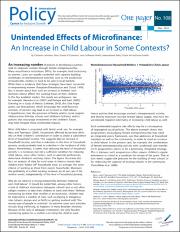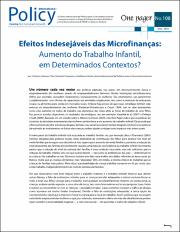Please use this identifier to cite or link to this item:
https://repositorio.ipea.gov.br/handle/11058/15891Full metadata record
| DC Field | Value | Language |
|---|---|---|
| dc.contributor.author | Lehmann, Christian | |
| dc.contributor.author | Hirata, Guilherme Issamu | |
| dc.date.accessioned | 2024-10-04T00:11:56Z | - |
| dc.date.available | 2024-10-04T00:11:56Z | - |
| dc.date.issued | 2010 | |
| dc.identifier.uri | https://repositorio.ipea.gov.br/handle/11058/15891 | - |
| dc.description.abstract | An increasing number of policies in developing countries seek to empower women through female entrepreneurship. Many microfinance institutions (MFIs), for example, lend exclusively to women. Loans are usually combined with capacity building workshops on entrepreneurial activities such as the production of handicrafts, clothes or food to be sold in local markets. While there is evidence that these strategies have been successful in empowering women (Panjaitan-Drioadisuryo and Cloud, 1999), less is known about how such an increase in mothers’ non-domestic labour affects the working hours of their children. In the few available studies, the results are ambiguous: see, for example, Hazarika et al. (2007) and Dehejia and Gatti (2002). Drawing on a study of Mexico (Lehman, 2010), this One Pager points out that policies which encourage the small business activities of women may lead to an increase in child labour. It hypothesises that the provision of family and/or social support infrastructure (full-day schools and childcare facilities), and/or policies that encourage investment in the children’s future, may help mitigate these unintended impacts. | en |
| dc.description.abstract | Um número cada vez maior das políticas adotadas nos países em desenvolvimento busca o empoderamento das mulheres através do empreendedorismo feminino. Muitas instituições microfinanceiras (IMFs), por exemplo, concedem empréstimos exclusivamente às mulheres. Tais empréstimos são geralmente complementados com oficinas de capacitação em atividades empresariais, tais como a produção de artesanato, roupas ou alimentos para venda em mercados locais. Embora haja provas de que essas estratégias tenham sido exitosas no empoderamento das mulheres (Panjaitan-Drioadisuryo e Cloud, 1999), não se sabe exatamente como este aumento no índice de trabalho não-doméstico das mães afeta as horas de trabalho de seus filhos. Nos poucos estudos disponíveis, os resultados são ambíguos: ver, por exemplo, Hazarika et al. (2007) e Dehejia e Gatti (2002). Baseado em um estudo sobre o México (Lehman, 2010), este One Pager indica que as políticas de incentivo às atividades empresariais das mulheres podem levar a um aumento do trabalho infantil. Ele postula que o fornecimento de infra-estruturas de apoio familiar e/ou social (escolas em tempo integral e creches) e/ou políticasde estímulo ao investimento no futuro das crianças podem ajudar a mitigar estes impactos não-intencionais. (...) | pt-br |
| dc.language.iso | en | |
| dc.title | Unintended Effects of Microfinance: An Increase in Child Labour in Some Contexts? | en |
| dc.title.alternative | Efeitos Indesejáveis das Microfinanças: Aumento do Trabalho Infantil, em Determinados Contextos? | pt-br |
| dc.type | One Pager | |
| dc.rights.holder | International Policy Centre for Inclusive Growth | |
| dc.rights.holder | United Nations Development Programme | |
| dc.location.country | Brasil | |
| dc.description.physical | 1 p. | |
| dc.rights.type | Licença total exclusiva | |
| dc.rights.license | O texto e dados desta publicação podem ser reproduzidos desde que as fontes sejam citadas. Reproduções com fins comerciais são proibidas. | |
| dc.subject.keyword | Unintended | |
| dc.subject.keyword | Effects | |
| dc.subject.keyword | Microfinance | |
| dc.subject.keyword | Increase | |
| dc.subject.keyword | Child Labour | |
| dc.subject.keyword | Contexts | |
| ipea.access.type | Acesso Aberto | |
| ipea.researchfields | N/A | |
| ipea.classification | Demografia. População | |
| ipea.classification | Educação | |
| ipea.classification | Sociedade. Participação Social. Controle Social | |
| Appears in Collections: | Publicações do IPC-IG | |
Files in This Item:
| File | Description | Size | Format | |
|---|---|---|---|---|
| en_IPCOnePager108.pdf | 223.99 kB | Adobe PDF |  View/Open | |
| pt-br_IPCOnePager108.pdf | 677.22 kB | Adobe PDF |  View/Open |
Items in DSpace are protected by copyright, with all rights reserved, unless otherwise indicated.

